Early childhood—which is generally defined as ages three through eight—is a foundational period when children rapidly move through milestones in physical, cognitive, social, emotional and language development (McCartney and Phillips, 2006). Cities offer unique environments for learning because they present young children with high densities of people from different backgrounds and cultures, buildings and public spaces that may reflect hundreds or even thousands of years of human history, and political systems that regulate environmental behaviors and decision-making.
In parks and along riverbanks, in vacant lots and gardens, the natural world weaves its presence. This chapter begins by identifying successive schools of thought in early childhood education that have encouraged the exploration of urban environments with young children. These traditions have pursued similar aims: creative self-expression, democratic decision-making, collaborative learning among peers and multiple generations, communication skills, and a deepening of children’s experiential, place-based learning. This chapter illustrates diverse ways these aims can be achieved in cities, including participatory planning and design, mobile preschools, greening the grounds of schools and childcare centers, gardening, and forest and nature schools in metropolitan areas. It draws examples from both resourced and poorly resourced schools and childcare centers in the global North and South.
Supportive teaching philosophies
The Reggio Emilia approach to preschool education, which grew out of the ruins of World War II in northern Italy, shared many goals of progressive education. It too sought to replace authoritarian systems of education with more tolerant, communal, equitable, and child-centered values that nurture democracy (Hall and Rudkin, 2011). Adopted by all municipal preschools in the city of Reggio Emilia, its influence has spread worldwide.
Because progressive education and the Reggio Emilia approach encouraged community democratic processes and projects that were motivated by children’s own interests, they opened spaces for investigation of the urban environment. Learning about the city and shaping it through participatory processes of urban design and planning were central aims of the built environment education movement that arose in Great Britain in the 1960s and 1970s. In 1969, the Skeffington Report to government made community consultation an integral part of planning. The Town and Country Planning Association responded by launching the “Bulletin of Environmental Education,” which advocated education to make people more aware, knowledgeable, and responsible for their interactions with the environment “in a manner explicitly constructed to enable them to work with others to take greater control of the shaping and management of their own world” (Bishop, Kean and Adams, 1992, p. 51). In combination with progressive initiatives in British primary schools that included learning through direct experience, team teaching, and field trips into neighborhoods, built environment education led to systematic curricula that brought architects, planners, artists and other experts into classrooms and sent students into the city to investigate and give input on local issues.
Ideals of community and democracy that run through progressive education, the Reggio Emilia approach, and built environment education persist in current expressions of education for sustainability in early childhood education. As Phillips (2014) observed in her discussion of education for sustainability, even very young children want to do “real things” that contribute to solving social and environmental problems. Integration of social and environmental systems, characteristic of education for sustainability, is also evident in the current international movement to naturalize grounds and plant gardens in schools and childcare centers as a means to bring nature into urban children’s lives (Danks, 2010).
Taken together, these pedagogical approaches suggest a set of more specific strategies that can inform early childhood environmental education in cities (Table 1). We illustrate these approaches and strategies using case studies of participatory planning and design and garden education below.
| Participatory Planning and Design | Garden Education | |
| Creative Self-Expression | Art-based methods, including murals, nicho boxes, videos, three-dimensional models | Songs, storytelling, cultural exchange |
| Collaborative Learning | Peer-to-peer and multigenerational learning through dialogue with city leaders and designers | Multigenerational and multicultural exchanges |
| Experiential, Place-Based Learning | Field trips and research about sites | Native plants and foods, ethnobotanic gardens |
| Development of Empathy | Recommendations for wildlife habitat in urban spaces including butterfly gardens and creek restoration | Community service, cultural exchange |
| Sample Recommendation | Tree houses near the library and creek to view and read about nature | Dissipation pond for rain catchment and water play |
Participation in planning and design of urban spaces
Growing Up Boulder is a child friendly city initiative that was formed in 2009 and is a formal partnership between the City of Boulder, Boulder Valley School District, and the University of Colorado’s Program in Environmental Design. While the initiative engages children of all ages, its work with young children (ages 3-8) has included participatory design of city parks, playgrounds, large-scale public spaces, neighborhoods, and open space. Growing Up Boulder fosters creative self-expression and collaborative learning through its methods of engagement, from nicho boxes (multimedia boxes inspired from Latin American folk art) and murals to three-dimensional models of recommended redesigns, which allow children to effectively express their ideas (Derr and Tarantini, 2016).
A critical aspect of Growing Up Boulder’s work with young children is developing partnerships in which teachers understand the value of participation in early childhood. One such partnership has been with the Boulder Journey School, a Reggio Emilia school. The school’s philosophies of honoring children’s own modes of expression, instilling a “pedagogy of listening,” and promoting children’s right to active citizenship (Hall and Rudkin, 2011) support participatory design and planning with ages 4-5. For example, Boulder Journey School students contributed to the redesign of Boulder’s Civic Area, a public space in the city’s downtown, through field trips, drawings and photographs, a presentation to city council, and participation as jurors in the city’s design competition (Derr and Tarantini, 2016).
Growing Up Boulder has also partnered with third graders (ages 8-9) from an ethnically and economically diverse school that utilizes the International Baccalaureate curriculum. Projects have included neighborhood design for increased density as well as redesign of public space (Derr and Kovács, 2015). The most recent project focused on resilience in partnership with Mexico City, as part of the Rockefeller Foundation’s 100 Resilient Cities network. The project allowed creative self-expression and collaborative learning both within and across schools, through video and mural exchange.
In Growing Up Boulder projects, children consistently consider the rights of others and show empathy toward other people and nature (Chawla and Rivkin, 2014; Derr and Tarantini, 2016). For example, in considering parks and open space, Boulder Journey School students researched physical features of insects and developed simple costumes of antennae and wings (Figure 1), and in the classroom, teachers projected large insect shadows on a wall so that children could experience the scale at which humans appear to insects. In their recommendations, students showed concern that insects might be hurt by visitors on trails and wanted to protect the insects and their homes. Growing Up Boulder has found that desires for nature protection and enhancement emerge across projects and ages, in early childhood and beyond (Chawla and Rivkin, 2014).

Children’s access to nature in the city
Bringing children to nature
In an effort to increase young children’s access to nature, many Canadian and European cities have established forest schools in which urban children walk to nearby forests or green spaces for some or all of their day (Elliott et al., 2014). Forest schools reach preschool through second grade and are integrated into both private and public school settings. In forest schools, children visit the same place on a regular basis, thus coming to know it and its cycles intimately. Teachers respond to children’s interests by listening to and writing down children’s ideas and then deepening students’ knowledge of nature and place. In Canada, forest schools also provide aboriginal specialists who integrate stories and cultural knowledge into place-based education (Elliott et al., 2014).
In response to shrinking school grounds that lack natural play areas, cities in Scandinavia and Australia have created mobile preschools, in which children ride a bus to natural areas and cultural places in the city. From their research with a mobile preschool in Sweden, Gustafson and van der Burgt (2015) caution that while this model may foster independence and increase children’s access to urban places, such programs face practical limitations from changes in weather conditions, the frequent need for outdoor toilets, and discussion of rules of behavior for different physical settings. This model provides a contrast to forest schools, which provide routine opportunities for learning through repeated visits to the same place.
Bringing nature to children
Naturalized childcare centers in North Carolina, U.S., are similar to forest schools in bringing nature to children where they learn and play. Moore and Cosco (2014) have found that community and ecosystem health fosters physical activity and a diversity of play types. Research comparing behaviors before and after naturalizing school grounds found children spent more time outdoors in all seasons; teachers created more vegetable gardens; children exhibited decreases in negative social behaviors, increases in imaginative play, and increases in play among peers with different abilities; and the community expressed increased pride about school grounds.
Perhaps the largest movement to increase children’s access to nature within the city is school gardens. As the following examples illustrate, gardens embody a whole systems approach to understanding life’s interconnections and involve children in interacting with plants and animals as they care for them. Tending a garden helps children to develop an ethic of caring, and to connect with themselves, the seasonal cycles, and the creatures that share the garden (Noddings, 2005). Integrating stories about plants, insects and animals into environmental education engages children in life’s wonders on a metaphorical and affective level. Songs tied to natural cycles deepen children’s relationship with what they plant by allowing children to sing, dance, and act as part of their experience.
Gardens at daycare centers: Puebla, Mexico and Rocinha, Rio de Janeiro, Brazil
A small international organization, A Child’s Garden of Peace, partnered with Casa Cuna, the only free daycare in Puebla, Mexico, to create a garden and nature education program on the daycare’s grounds (Figure 2). Secondary schools and universities in Puebla (population 2 million) require several hundred hours of community service from their students. As a service project, about 60 youth prepared the Casa Cuna ground for planting. None had ever held a shovel or planted a garden. They worked with children, aged 2 to 5, to plant herbs, vegetables, flowers and fruit trees. Everyone learned together. The garden also includes a shade structure where children rest and participate in garden-inspired art and music activities. Children’s senses lead their garden explorations. The youth and children water the garden daily, discover what has bloomed or become ripe for picking, and carry the harvest to the school kitchen.
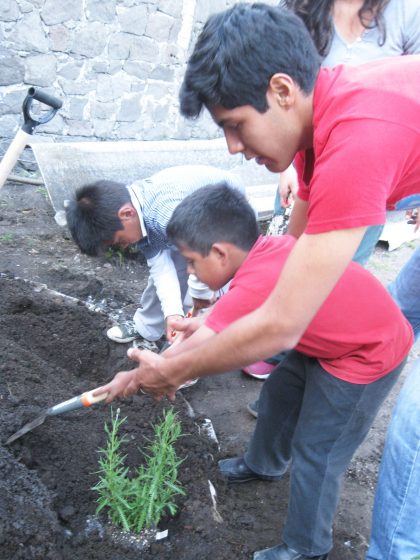
When early childhood centers lack land for a garden, large pots filled with soil can provide planting space. In Rocinha, Brazil’s largest favela where over 100,000 people live on a granite hillside, the Associação Social Padre Anchieta Daycare has no land except the building’s footprint. The school’s roof provides a small outdoor play area, and one 10-square-foot area bordered by a 6-inch raised edge became a small garden with the addition of compost donated by a local environmental group. Children used the small plot and large plastic pots to plant garlic, onions, beets, lettuce, collards, herbs and flowers, which in turn enhanced nutrition and flavor of meals, attracted pollinators, and added color and life to the daycare, creating a sanctuary from street dangers.
Educational gardens: Vancouver, British Columbia, Canada
The “Spirit of Nature” garden was initiated by two University of British Columbia students at the Grandview/U’uquinakuh Elementary School and Grandview Daycare Center in 1998. Children, teachers and neighbors engaged in all phases of planning and implementation. Models created by children inspired a landscape architecture student’s one-acre design including a butterfly garden, wild bird habitat, ethnobotanic garden, school vegetable garden, community garden, an outdoor classroom modeled after an indigenous longhouse building, and a dissipation pond. The dissipation pond—in which sand and crushed shells mimic a coastal beachfront and absorb falling rainwater—represents a compromise between children who wanted a pond and the school board who prohibited it for liability reasons (Bell, 2001). The rain catchment system provided a superb play space, affording opportunities for dam building and leaf sailing on rainy days. The Vancouver Coastal Health Authority has funded a garden coordinator/classroom educator since 2001. Lessons for early grades integrate science, culture, and math. For example, students make graphs to measure seedling growth and use an abacus fence to count harvests. The librarian also hosts story times that thematically link garden eating with books about the plants being eaten.
Gardens can facilitate cross-cultural knowledge exchange in diverse urban communities. Elders who live adjacent to the garden in Grandview’s public housing created a book titled “The Web of Life” to share their childhood garden experiences as indigenous peoples of Canada and as immigrants from other countries. The First Nations’ school members also held a community-wide ceremony in which native chiefs, dancers and singers came in full regalia to bless the gardens and longhouse with its totem poles carved on site. As they play in the native maple tree’s shade or under the longhouse roof on a rainy day, children experience wildlife attracted by the native plants and engage in a cultural environment honoring local heritage (Pevec, 2003).
Conclusion
This chapter describes educational approaches that encourage children’s exploration of built and natural settings in cities. These approaches provide opportunities for children to express empathy for other living beings and respect for diverse cultures. Through the participatory design of a playground, a garden space, or a public park, children develop a sense of agency and competence and increase their understanding of the processes that shape a city. Through field trips and gardening, they learn about natural cycles and systems. These experiences lay a foundation for the development of environmental responsibility and stewardship. According to the ideas of John Dewey, Reggio Emilia preschools, and built environment education, social and environmental challenges cannot be solved through authoritarian, technocratic decision-making. Successful problem-solving requires the intelligence, creativity, and collaborative resourcefulness of all sectors of society, including young children. Early childhood is the time to begin teaching these skills. By bringing children out of their childcare centers and classrooms into the built and natural spaces of their cities, and by involving children in naturalizing built surroundings, urban environmental education contributes to cities where human constructions and natural processes can productively co-exist for all ages.
Victoria Derr, Louise Chawla, and Illène Pevec
Boulder, Boulder, and Basalt, CO
* * * * *
This essay will appear as a chapter in Urban Environmental Education Review, edited by Alex Russ and Marianne Krasny, to be published by Cornell University Press in 2017. To see more pre-release chapters from the book, click here.
References
Bell, A. (2001). Grounds for learning: Stories and insights from six Canadian school ground naturalization initiatives. Canada: Evergreen.
Bishop, J., Kean, J. and Adams, E. (1992). Children, environment and education. Children’s Environments 9 (1), 49-67.
Chawla, L. and Rivkin, M. (2014). Early childhood education for sustainability in the United States of America. In Davis J. and Elliott, S. (Eds.), Research in early childhood education for sustainability: International perspectives and provocations (pp. 248-265). London: Routledge.
Danks, S. (2010). Asphalt to ecosystems. Oakland, California: New Village Press.
Derr, V. and Kovács, I. (2015). How participatory processes impact children and contribute to planning: A case study of neighborhood design from Boulder, Colorado, USA. Journal of Urbanism: International Research on Placemaking and Urban Sustainability.
Derr, V. and Tarantini, E. (2016). “Because we are all people”: Outcomes and reflections from young people’s participation in the planning and design of child friendly public spaces. Local Environment: The International Journal of Justice and Sustainability.
Elliott, E., Eycke, K., Chan, S. and Müller, U. (2014). Taking kindergarteners outdoors: Documenting their explorations and assessing the impact on environmental awareness. Children, Youth and Environments, 24(2), 102-122.
Hall, E.L. and Rudkin, J.K. (2011). Seen and heard: Children’s rights in early childhood education. New York: Teachers College Press.
Gustafson, K. and van der Burgt, D. (2015). ‘Being on the move’: Time-spatial organization and mobility in a mobile preschool. Transport Geography, 46, 201-209.
McCartney, K. and Phillips, D. (Eds.). (2006). Blackwell Handbook of Early Childhood Development. Malden, Massachusetts: Blackwell Publishing.
Moore, R. and Cosco, N. (2014). Growing up green: Naturalization as a health promotion strategy in early childhood outdoor learning environments. Children, Youth and Environments, 24(2), 168-191.
Noddings, N. (2005). The Challenge to Care in Schools: An alternative approach to education. 2nd edition. New York: Teachers College Press.
Pevec, I. (2003). Ethnobotanical gardens: Celebrating the link between human culture and the natural world. Green Teacher, 70, 25-28.
Phillips, L.G. (2014). I want to do real things: Explorations of children’s active community participation. In Davis, J. and Elliott, S. (Eds.), Research in Early Childhood Education for Sustainability (194-207). London: Routledge.
Zilversmit, A., (1993). Changing schools. Chicago: University of Chicago Press.
about the writer
Louise Chawla
Louise Chawla is a Professor in the Environmental Design Program in the University of Colorado Boulder.
about the writer
Illène Pevec
Dr. Illène Pevec currently works as program director for Fat City Farmers, Inc.

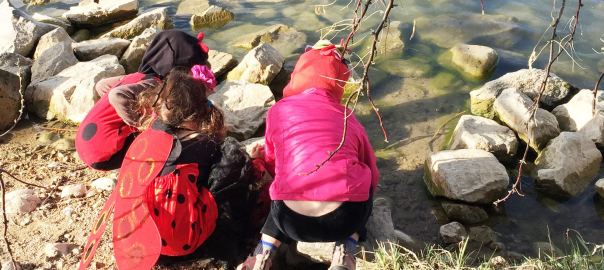






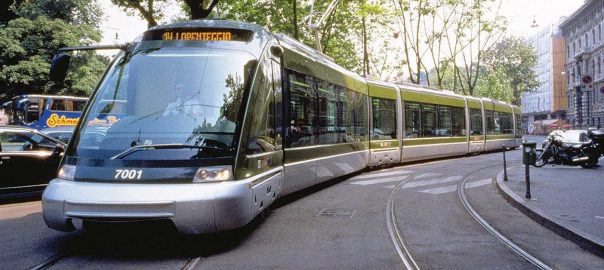
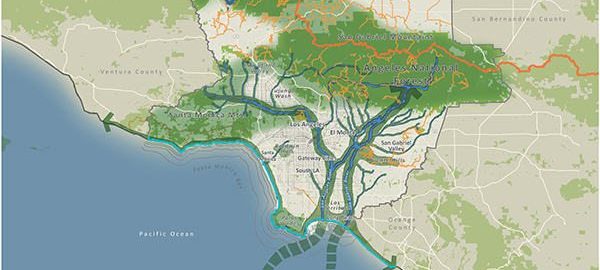
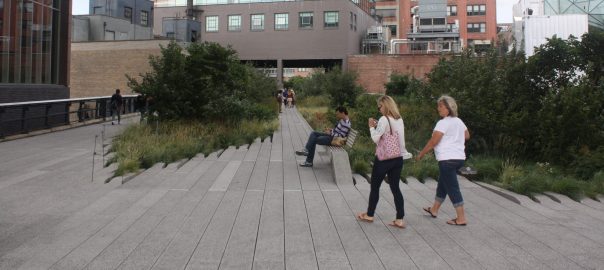
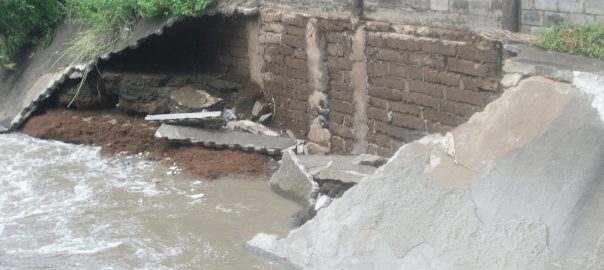
Amazing Blog! You’re a great writer! I found this blog wonderful too. Because in this blog kids can catch the outdoor activities also. Little Atlas Preschool is an incredible childcare centre near me that provides an extra curriculum for kids as well as experienced staff who will help your kids learn new things and grow day by day. I really appreciate it. Thank you so much!
Very interesting, informative and well written. I totally support children growing things.
There are few things sadder than the urban child for whom nature is ‘out there’ to be experienced in controlled ways with adult supervision. The world is real but a child needs silence and solitude to connect with it. Children need trees to climb. They need to hear birds song, feel the wind, and be out in wild spaces where they can develop a sense of awe and wonder. Only then will we have a generation that feels deeply the loss of the natural world and is willing to sacrifice a luxurious lifestyle in order to live in harmony with other species.
I am always struck by how much of the writing on this blog is from rich countries that are the root of the problem while the countries with the rich biodiversity that is disappearing are much less audible.